Language/ethnicity, tribal rivalry, migration, control over local resources and a widespread feeling of exploitation and alienation have resulted in violence and diverse demands by various Indian Insurgent Groups (lIGs). The demands vary from sovereignty in some cases to independent State or Homeland or simply better conditions for ethnic groups they claim to represent. The underground outfits indulge in violent and terror activities and intimidate people with arms in order to achieve their objectives/demands. They maintain crossborder links, procure arms, recruit and train their cadres, and indulge in unlawful activities such as damaging of public properties, bomb explosions, extortions, killing of innocent civilians, Security Forces Personnel, attacks on/abduction of Government employees, politicians, and businessmen.
Historical Background
At the commencement of the Constitution, the present States of Nagaland, Meghalaya and Mizoram constituted as part of Assam, whereas Arunachal Pradesh, (then NEFA), consisted of several ‘frontier tracts’ administered by the Governor of Assam. The States of Manipur and Tripura were princely States which, after merger with India in 1948, became “Part C” States, the earlier name for Union Territories. The Constitution-makers, recognising the diverse way of life and administrative set up, provided for special institutional arrangements for the tribal areas in the region, giving them a high degree of self governance through autonomous District Councils under the Sixth Schedule of the Constitution.
Geography
Arunachal Pradesh, Assam, Manipur, Meghalaya, Mizoram, Nagaland, Tripura and Sikkim are eight states located in the North-East of the country and command special importance to India, not only because of their location but also their cultural and historical uniqueness. The landscape, the range of communities and geographical and ecological diversity make these states quite different from other parts of the country. They are known as eight siblings and referred to as ‘eight sisters’ or ‘seven sisters and one brother’. These states cover an area of 2,63,179 sq. km, approximately eight per cent of the country’s total geographical area and house around 3.76 percent of the total population the country. Around 98 percent of the boundary of these states has international borders.
The states have distinct cultures and multiple ethnic groups and are a fine example of unity in diversity. The variety of ethnic groups, languages and religions reflect the multi-cultural character of the states. The region houses over 220 of the 705 tribal groups in the country, speaking a variety of Tibeto-Burman languages and dialects. States like, Arunachal Pradesh, Meghalaya, Mizoram and Nagaland are predominantly inhabited by tribals with a certain degree of diversity among the tribes. States like, Assam, Manipur, Tripura and Sikkim are inhabited by people of various religious denominations like , Hindus, Christians, Muslims and a combination of local tribes and communities.
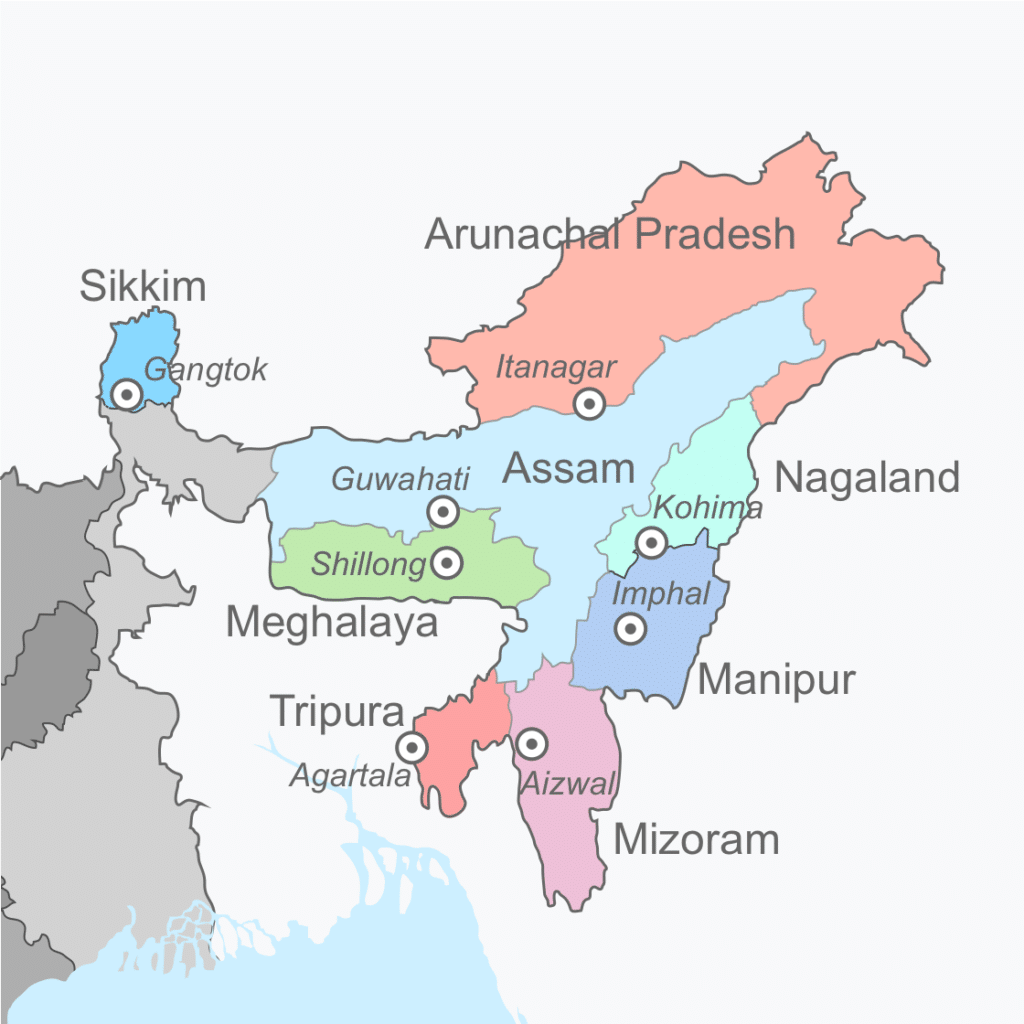
Interdependence
The North East India is commonly described as “Land of Seven Sisters” because of their interdependence on each other. All the seven states are isolated from India and only way to reach there is via Siliguri Corridor (also called Chicken’s Neck) in West Bengal. Tripura is like an enclave surrounded by Bangladesh and depends on Assam for transportation. Most of the rivers that floods the plain in Assam originates in Arunachal Pradesh and Nagaland. Mizoram and Manipur are connected to rest of India through Barak Valley in Assam. Due to this interdependence, they were given sobriquet “The Land of Seven Sisters” by Jyoti Prasad Saikia (A civil servant from Assam).
Political Unrest
Northeast India has been facing political unrest for nearly a century. The state of Arunachal Pradesh was claimed by China as South Tibet, which led to the SinoIndia war in 1962. However, unrest in Northeast India began even before the Sino-lndian War. More recently, insurgence in Northeast India have further isolated the region from the rest of India. This political unrest has made it more difficult for people to travel in and out of the region, constricting the flow of culture and language in a similar way with which the Indian Independence and the Sino-lndian War did.
Status of Insurgency in States
Currently, numerous insurgents groups are active in different North-Eastern states, particularly in Assam, Manipur, Meghalaya and Tripura. Some of these are: Assam – United Liberation Front of Assam (ULFA) and National Democratic Front of Bodoland (NDFB); Manipur – People’s Liberation Army (PLA), United Liberation Front (UNLF), People’s Revolutionary Party of Kangleipak (PREPAK), Kangleipak Communist Party , Kanglei Yaol Kanba Lup (KYKL), Manipur People’s Liberation Front (MPLF) and Revolutionary People’s Front (RPF); Meghalaya – Achik National Volunteer Council (ANVC) and Hynniewtrep National Liberation Council (HNLC); Tripura – All Tripura Tiger Force (ATTF) and National Liberation Front of Tripura (NLFT); Nagaland – Nationalist Socialist Council of Nagaland (Khaplang)-[NSCN(K)].
Arunachal Pradesh
- History: Arunachal Pradesh literally means land of dawn-lit mountains. Carved as a full-fledged state in 1987, the evolution and formation of Arunachal is a testimony to the idea of federalism in modern India. Arunachal has a diverse culture, mountainous terrain and scenic beauty. It is an enthralling place and a perfect example of micro-India representing the idea of unity in diversity. Arunachal is comparatively a new state. Before it got its statehood on 20 February 1987, it was a Union Territory (UT) for 15 years since 1972. The name Arunachal Pradesh was first given then. Prior to that, it was known as the North East Frontier Agency (NEFA) and was under the direct administration of the Ministry of External Affairs, Government of India.
- Insurgency: Insurgency in Tirap and Changlang district of Aunachal Pradesh started in early 2000s, due to rivalry between two factions of NSCN. The insurgency in Tirap is not indigenous and the locals do not identify with the Naga cause. Arunachal Pradesh has also been used as a transit route by the United Liberation Front of Assam (ULFA). Tirap, Changlang and Longding districts and a 20 Kilometer belt having a common border with Assam has been declared as a disturbed area under the AFSPA-1958.
- Current Situation:
- It was lack of governance which had led to the rise of insurgency in Tirap and Changlang. Administration over the years has played along with the local politics and the insurgents.
- The warring groups of NSCN (IM) and NSCN (K) have been in ceasefire agreements with the union government, but the terms of the ceasefire apply only to the territory of Nagaland, a loophole that the insurgents are exploiting to engage in continuous armed activities.
- Another major concern is the ready procurement of arms by the insurgents from China while local industry has become a source of extortion.
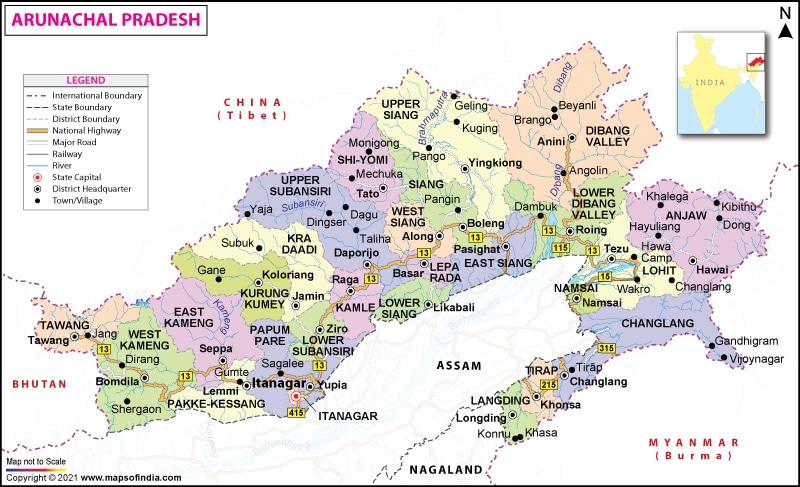
Assam
- History: History of Assam is confluence of the Tibeto-Burman (Sino-Tibetan), Indo-Aryan and Austroasiatic cultures. The colonial era began with the establishment of British control after the Treaty of Yandaboo in 1826 after first First Anglo-Burmese War. Assam is the gateway to north east India and comprises of riverine plains, interspersed with low hills, reserve forest and numerous nallahs and rivers. It is connected to the rest of India by a narrow corridor at Siliguri. In 1947, Sylhet less Karimganj division was transferred to Pakistan thus Assam and north east region remained isolated from the rest of India for over two years. Assam was linked with rest of India in 1950.
- Assam is a melting pot of many cultures and has a large number of tribes. The main demographic pattern is composed of Assamase (Hindus and Muslims), Bodos and others including Christians, Sikhs, Buddhists and Jains. Demographic pattern generally dictates areas of influence of various militants groups.
- After independence, large scale influx of migrants occured in Assam, which was tilting the demographic balance against original inhabitants. It also created large scale unemployment in Assam. The overall economic backwardness coupled with official indifference to the migration issue further compounded the already existing problems. A number of groups emerged who voiced for greater autonomy and statehood. These groups were All Assam Students Union (AASU), All Assam Gana Sangram Parishad (AAGSP), All Bodo Students Union (ABSU) and United Liberation Front of Assam (ULFA). The Assam Accord was signed in 1985 between AASU, Union government and Assam Government. Under the accord, all those who came to Assam after 25 March 1971 were to be detected and deported.
- Incoming of illegal immigrants from Bangladesh is even today a big issue which is plaguing Assam and now taking communal flare.
- ULFA and its Claim: The United Liberation Front of Assam (ULFA) was formed in 1979. The armed insurgency by ULFA germinated from the popular Assam Movement, out of which it emerged as an insurgent organisation demanding creation of a sovereign socialist Assam from the Indian Union. After a prolonged Counter Insurgency (COIN) campaign, the outfit entered in peace talks with the Government of India in 2011. The peace talks with the group saw a split in the organisation- ATF (AntiTalk Faction) led by Paresh Baruah of the ULFA and the Pro-Talk Faction (PTF), led by Arabinda Rajkhowa. While the outcome of the peace talks are still awaited, it is observed that the ULFA (I) (Independent, ATF) has been successful in gaining its strength after the organisational split and currently with nearly 300 cadres, it operates at the inter-state border areas along the Nagaland and Arunachal Pradesh. The outfit also continued to remain indulged in killing civilians and harassing population through extortion in the name of protection money or business tax from the business houses.
- Recent reports indicate that the ULFA (I) has formed a nexus with the National Socialist Council of Nagaland – Khaplang (NSCN-K) and the present areas where the ULFA (I) operates fall under its (NSCN-K) jurisdiction. Furthermore, what is more critical is the fact that the ULFA (I) is also a member of the newly formed conglomerate of the militant groups in the Northeast – the United National
- Liberation Front of Western South East Asia (UNLFWSEA) and thereby adds to the renewed dimension of threat perception for the Indian State. Apart from the ULFA (I), other active insurgent outfits are the National Democratic Front of Bodoland (NDFB-S), Kamtapur Liberation Organisation (KLO) and Karbi People’s Liberation Tiger (KPLT). These outfits have also been the major elements in derailing the ongoing peace process in the state.
- NDFB: The National Democratic Front of Bodoland (NDFB) led by Rajan Daimary came into existence in 1986. The demand of the Bodos has successively changed from autonomy to separate state. The area of influence of the group covers the districts of Kokrajhar, Kamrup, Sonitpur, Chirang, Darrang, Baksa, Udalgiri, Barpeta and Bongaigaon in lower Assam. The government of India and the government of Assam had made concerted efforts for the Bodo areas in the state of Assam by signing the accord on 10 February 2003 with the Bodoland Liberation Tiger Front (BLTF). This finally paved the way for the formation of the Bodo Territorial Council (BTC) comprising the districts of Kokrajhar, Chirang, Baksa and Udalgiri. This did not have the approval of the NDFB. Bodo agitation for a separate Bodoland comprising the Bodo dominated areas was contained to an extent. The objective was to promote autonomy within the framework of the Indian Constitution to the Bodos for socio-economic, educational, ethnic and cultural advancement. However, the NDFB a militant outfit active in lower Assam, particularly the Bodo dominated area continued with its movement.
- Ceasefire: The army came down heavily on the NDFB in a series of counter operations, forcing them to retreat to Bhutan. In the early 2000s, the Indian Army with the help of the Royal Bhutan Army launched a massive operation to eliminate NDFB militants hiding in Bhutan. A tripartite agreement was signed between the government of India, the Assam government and NDFB on 25 May 2005 for holding peace talks. Now, Rajan Daimary’s deputy, Ingti Kathar Songbijit, who was firmly against any kinds of peace talks and unwavering in his demand for a separate Bodoland, split from the outfit along with his supporters and formed the NDFB(S). It carries out incidents of militancy sporadically.
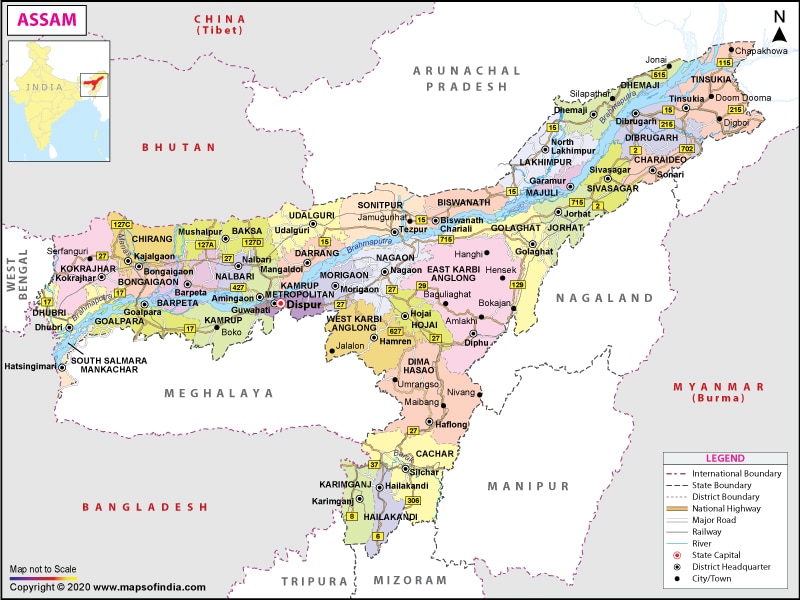
Meghalaya
- History: The state of Meghalaya, formed on 21 January 1972, was carved out of the state of Assam. Meghalaya comprises the United Khasi Hills, Jaintia Hills and Garo Hills. The total geographical area of the state is 22,429 sq. km with a population of 29.67 lakh (Census 2011). It is home to three major tribes—Khasis, Pnars (Jaintias) and Achik (Garos).
- Insurgency: The influx of foreign Nationals from Bangladesh and Nepal and outsiders has created an anti outsider feeling particularly amongst the youth of Meghalaya and is the main cause of adverse sentiment amongst them. The north east insurgents have found Meghalaya, particularly Shillong a convenient hideout for rest and recoup. Hynniewtreps and the Achiks are the two tribal groups prevalent in Meghlaya. Achik National Volunteer Council (ANVC) and Hynniewtrep National Liberation Council (HNLC) are the main groups in the state. However, the Garo National Liberation Army (GNLA) is now playing an important role demanding separate Garoland. In Meghalaya, the central police organizations (CPOs) are responsible for the counter insurgency in the disturbed areas. The limitation of the CPO‘s is that they lack in the intelligence machinery. The police are suffering because of this and in the bargain they have suffered heavy casualties.
- Current Situation: The GNLA cadre is quite well trained, but the combined efforts of the police and the border security force (BSF) have resulted in cutting the communications and the supply routes of the GNLA from across the border from Bangladesh.
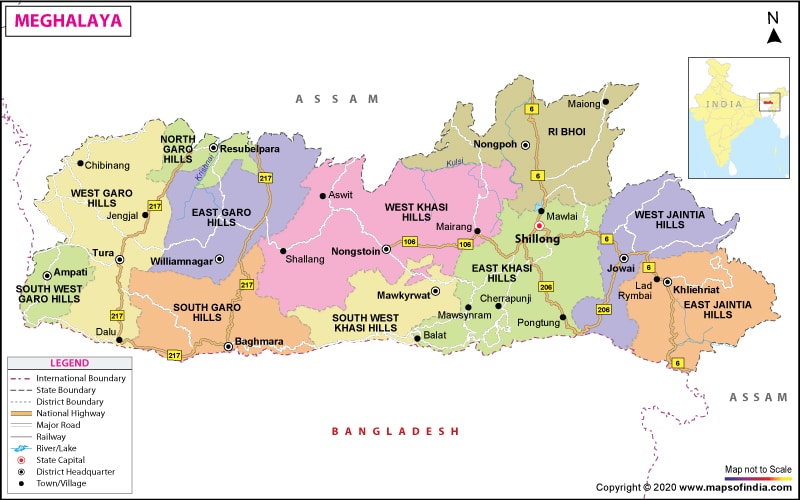
Mizoram
- History: During the colonial period, the present Mizoram state was known as the Lushai Hills which was later in 1898 constituted as a separate district in Assam. In 1936, it was declared as an excluded area under the inner line regulations. The Mizo Union was formed as the first political party by the Mizos. In 1954, district and village councils were constituted and separation from Assam was demanded.
- Insurgency: In 1959-1960, there was a famine and it resulted in forming of Mizo National Famine Front (MNFF) to provide relief to the people. In 1960, the people were not satisfied with the measures taken by the Assam Government and thus MNFF was converted into Mizo National Front (MNF). On 21st December 1961, the MNF declared its aim, to unify all Mizos under a single administration and to achieve freedom. The central government did not accept the demand for independence, resulting in a rebellion by the MNF and launching of ‘Operation Jericho’ on 28 February 1966. There were clashes with the security forces and police stations, telephone exchanges, government offices were raided. The army was called and the situation was restored, resulting in the MNF insurgents escaping to East Pakistan and after the 1971 war, to Burma. In January 1972, Mizoram was constituted into a union territory. In 1986 Mizo Accord was signed, the MNF laid down their arms and the personnel were rehabilitated.
- Independence Movement and Formation of the State: The Mizo accord was signed in 1986 between the MNF and the government of India as a result of Operation Jericho. The MNF agreed to work within the Indian constitution and to renounce violence. This has been successful and has resulted in a new article 371-G to be inserted in the constitution by the government of India for safeguarding the identity of the Mizos. The main reasons for success of the accord were that the political demands of the militant leaders were met and the minor tribes were integrated into a cohesive identity and were made a part of the whole system The central government played an important role by funding development work and for financing packages to the family members who had suffered during the counter insurgency operations. Surrendered militants were rehabilitated and settled. The church was of a great help as it brought about high literacy and health status, as also the transformation of the Mizo society into a modern society. Mizoram gained its statehood on 20th February 1987. There is the Autonomous Council of the Chakmas, Brus and Hmars. The Chakmas are basically non-Muslims and are also across in the Chittagong Hill Tract.
- Current Situation: Mizoram is a peaceful state and the main cause of worry is the illegal migration from Myanmar and the insurgent groups using the state as a corridor for cross border movement of cadres and weapons.
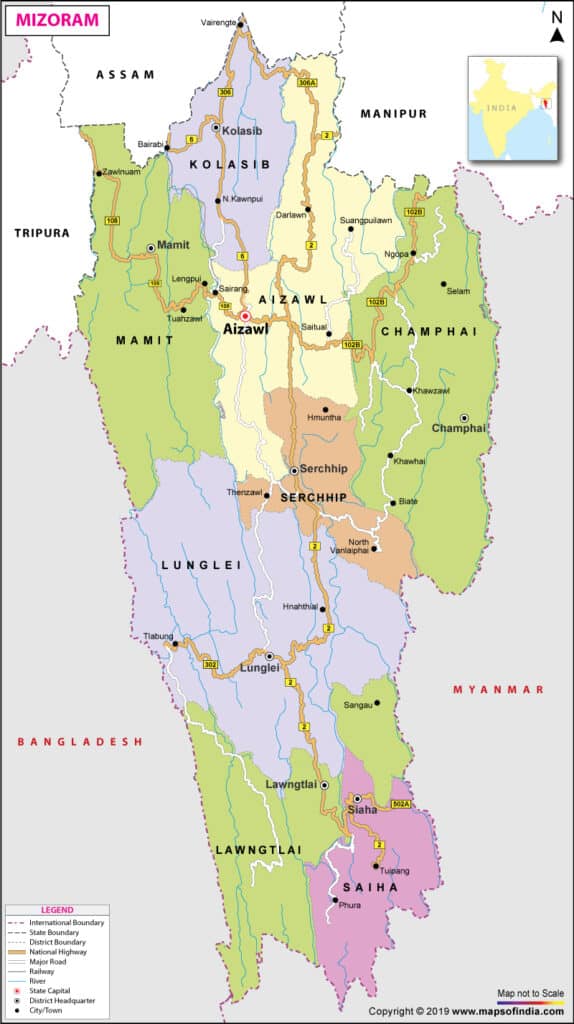
Manipur
- History: Manipur became a princely state under British rule in 1891, the last of the independent states to be incorporated into British India. During the Second World War, Manipur was the scene of battles between Japanese and Allied forces. Kingdom of Manipur was merged with the Indian Union on 15 Oct. 1949. It was made a union territory in 1956 and a full-fledged state in 1972.
- Insurgency: The emergence of insurgency in Manipur is formally traced to the emergence of the United National Liberation Front (UNLF) on 24th November 1964 when the Naga and the Mizo insurgents put the north eastern region under fire. The alleged ‘forced’ merger of Manipur and the delay in the conferring of full-fledged statehood to it was greatly resented by the people of Manipur.
- Differences of the Hill and the Valley Areas: The valley region is mostly inhabited by the Meitei’s and Manipur Muslims, locally called the Pangals. The hilly region in contrast is inhabited by the tribals with the Nagas to the north and Kukis and Mizos to the south. These hill tribes are generally Baptist Protestants, whereas Meitei people follow Hinduism.
- Valley based insurgent groups like People’s Liberation Army (PLA), United National Liberation Front (UNLF), People’s Revolutionary Party of Kangleipak (PREPAK) etc., demanding a separate independent Manipur and are against the concept of Nagalim while Hill Based Insurgent Groups are supporter of violence spilled from NSCN(K) for greater Nagalim.
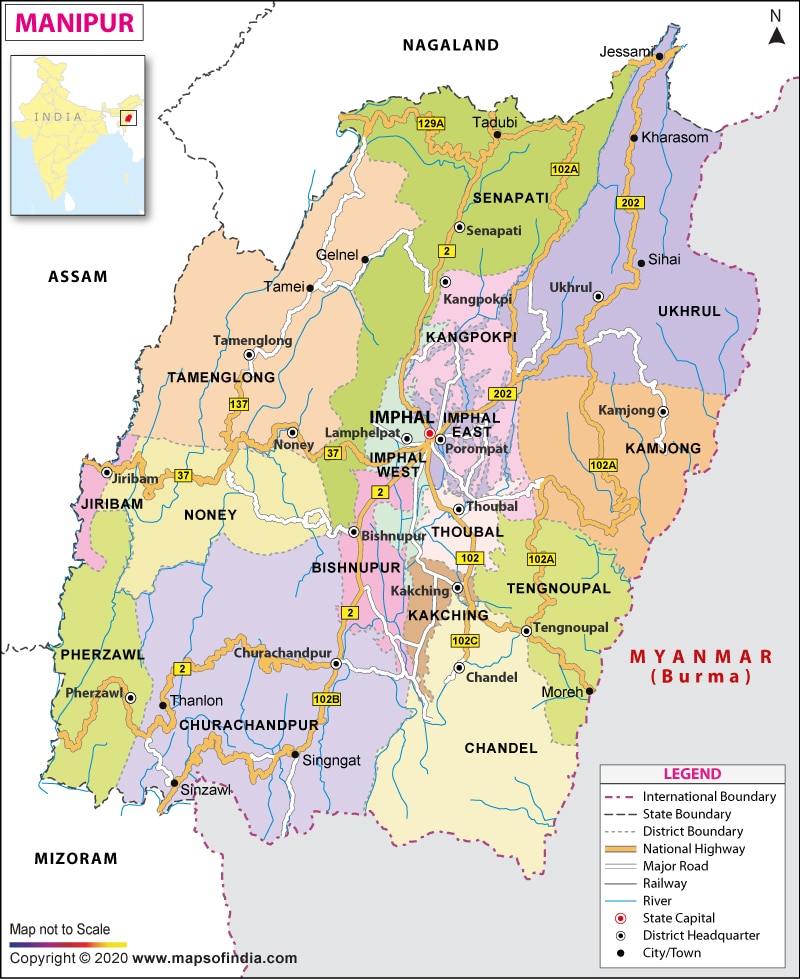
Nagaland
- History: The British annexed Assam in 1826, and in 1881, the Naga Hills too became part of British India. The first sign of Naga resistance was seen in the formation of the Naga Club in 1918, which told the Simon Commission in 1929 “to leave us alone to determine for ourselves as in ancient times”. In order to unite all Nagas under one umbrella, the Naga National Council (NNC) was formed under the leadership of Angami Zapu Phizo in 1946.
- Statehood: After the Independence of India, a separate Tuensang administrative circle was constituted as an outpost of Mokokchung subdivision and its headquarter was set up at Tuensang. In 1957, Tuensang was retransferred from NEFA to Naga Hills to form a new administrative unit known as the Naga Hills Tuensang Area (NHTA) and become a Union Territory. In July 1960, following a discussion between the then Prime Minister, Pandit Jawaharlal Nehru and leaders of the Naga People’s Convention (NPC), a 16-point Agreement was arrived at, whereby the Government of India recognised the formation of Nagaland as a fullfledged state within the Union of India. On 1 December 1963, Nagaland become the 16th state of the Indian Union.
- Insurgency Movements: National Socialist Council of Nagaland (NSCN) was formed in 1980. They didn’t agree to the peace agreement and their activities included collection of taxes and recruiting personnels. Split in NSCN in 1988 resulted in formation of two groups i.e. NSCN (Issac – Muivah) and NSCN (Khaplang). It was split along the tribal lines with Tanghkuls and Sernas (NSCN (IM)) parting from Konyaks (NSCN (K)). The NSCN (IM) shifted to Myanmar opposite the Ukhrul District of Manipur and the areas along the Nagaland Assam border. However, NSCN (K) continued their bases in Myanmar. There was a further split in NSCN (K) in 2011.
Demands of NSCN (IM)
- A “Greater Nagalim” comprises of “all contiguous Nagainhabited areas”, along with Nagaland. That includes several districts of Assam, Arunachal and Manipur, as also a large tract of Myanmar. The map of “Greater Nagalim” has about 1,20,000 sq km, while the state of Nagaland consists of 16,527 sq km. The claims have always kept Assam, Manipur and Arunachal Pradesh wary of a peace settlement that might affect their territories.
- The Nagaland Assembly has endorsed the ‘Greater Nagalim’ demand — “Integration of all Naga-inhabited contiguous areas under one administrative umbrella” — as many as five times: in December 1964, August 1970, September 1994, December 2003 and as recently as on July 27, 2015. The Government of India signed a ceasefire agreement with NSCN (IM) on July 25, 1997, which came into effect on August 1, 1997. Over 80 rounds of talks between the two sides were held subsequently.
- Peace Process: There was a 16 Point Agreement which was signed between the government of India and the Naga people’s convention in July 1960. Thereafter, after a number of talks, a cease fire agreement was signed between the government of India and NSCN (IM) in December 1997 and NSCN (K) in 2001. After the split, ceasefire agreements were signed by the Government of India and NSCN (K) and GPRN/NSCN in 2012. There is an indefinite ceasefire with the NSCN (IM) by the Government of India, but the ceasefires with the NSCN (K) and GPRN/NSCN are to be renewed annually.
- Recent Developments: In 2015, a ‘Framework Agreement’ was signed, where 6 rebel groups and NSCN (IM) joined the peace process.
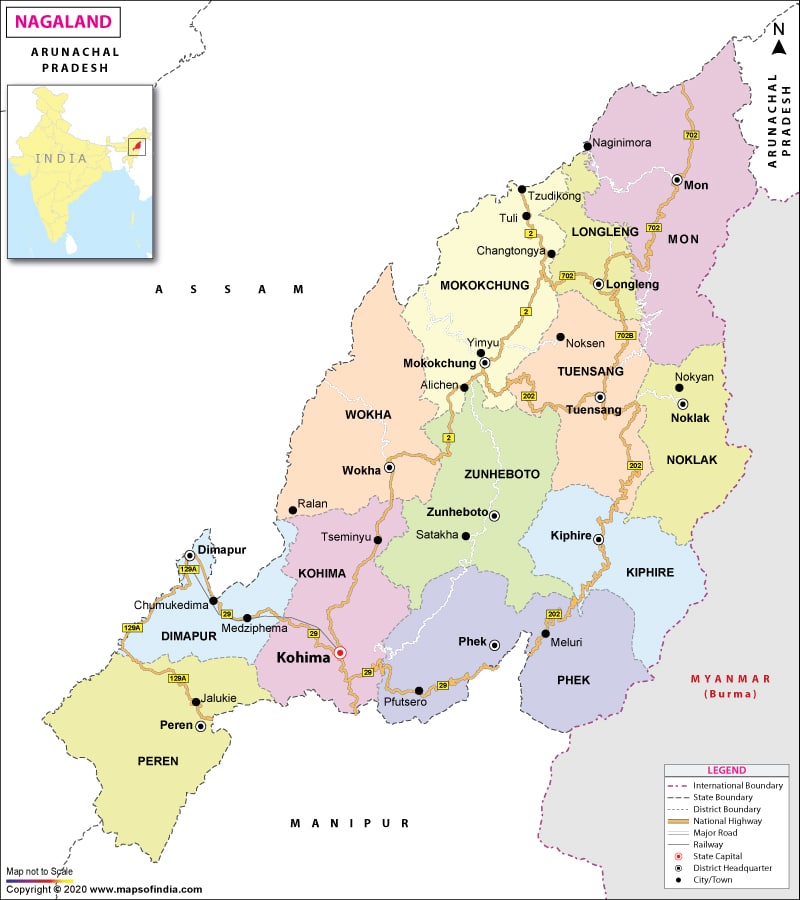
Tripura
- History: Tripura was a princely state, which had acceded to the Indian Union at the time of independence, and its administration was taken over in October 1949. It became a Union Territory on November 1, 1956 and a full -fledged state on 21 January 1972.
- Insurgency:
- Insurgency in Tripura is also rooted in influx of illegal migrants.
- In May 1967, Tripura Upajati Juba Samiti (TUJS), a tribal party, was formed which wanted the provisions of the Fifth Schedule of the Constitution (granting tribal autonomy) promulgated in Tripura. In December 1978, The Tripura National Volunteers (TNV) was formed with the aim of securing independence for Tripura by armed action. Later, Autonomous district council was created under the Sixth Schedule of the Constitution in July 1985. The entire state was declared as a disturbed area on 29 January 1988. The June 1988 riots in Tripura wherein 1300 people died, mostly Bengalis, was seen as ethnic cleansing by the TNV, which was disbanded later. In 1989 and 1990, National Liberation Front of Tripura (NLFT) and All Tripura Tiger Force (ATTF) were raised respectively, which still exist.
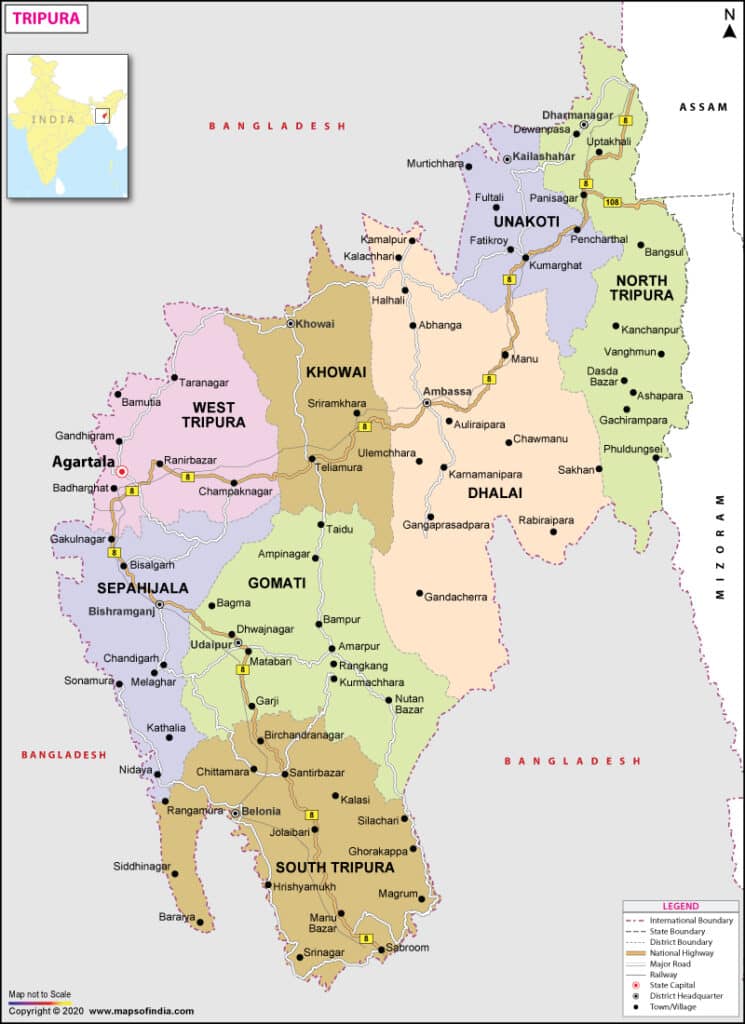
Factors Causing Insurgency
Historical
- British Policies: British policy of administering NE states as loose frontier removed contact and mingling of people from mainland India and NE India, thus creating a sense of alienation in people of NE states.
- Inner Line Permit Regulation: The Inner Line Permit (ILP) Regulation is a special pass or permit that is required to enter the Northeastern states of Arunachal Pradesh, Nagaland and Mizoram. The system was introduced by the British to protect their commercial interests, particularly in oil and tea, and continues now essentially as a mechanism to firewall the tribal peoples and their cultures from outsiders.
- Backward Tracts: British government decided to remove the remote backward tract of British India from the operation of General Acts and Regulations under Scheduled District Act, 1874, thus excluding them from the ambit of legislative reforms in mainland India. The Chief Commissioner of Assam was empowered to remove any part of Assam from the operation of enactment in force there as per the Assam Frontier Tracts Regulation, 1880. As per Section 52A of Government of India Act, 1915, as amended by Government of India Act, 1919, as per the recommendations of the Montague Chelmsford Report, 1918, the Governor-General in Council was empowered to declare any territory to be a ‘backward tract’ and deny application of any legislative Act in such areas. Accordingly, the Garo Hills District, the Khasi and Jaintia Hills district (except Shillong Municipality and Cantonment Area), the Mikir Hills (in Nowgong and Sibsagar districts), the North Cachar Hills (in Cachar district), the Naga Hills district, the Lushai Hills district, and the Sadiya, Salipara and Lakhimpur Frontier Tracts were declared as ‘backward tracts’. The Indian Statutory Commission, 1930 (Simon Commission) examined the administrative position of the backward tracts and made certain recommendations which were included in the Government of India Act, 1935. In 1936, backward tracts were regrouped under excluded and partially excluded areas. The segregation of the people brought about racial awareness which acted as a major catalyst for future insurgency movements.
- Political Integration Post-Independence: NorthEast India is ethnically, linguistically and culturally very distinct from the other parts of India. It was territorially organised in such a manner that ethnic and cultural specificities were not paid due attention during the process of delineation of state boundaries in the 1950s, giving rise to discontentment and assertion of one’s identity. Hence, their allegiance to the newly formed Indian nation-state was lacking from the beginning.
Geographical
- Porous International Border: Northeast region comprises India’s border with neighbouring countries like China, Bangladesh, Myanmar, Bhutan and Nepal. The border demarcation over the river is not entirely clear.
- Dense forests: The region has a vast coverage of forest with more than 55 per cent of the total geographical area. Thick vegetation restricts both ground and aerial observation.
- Difficult Terrain: NE terrain is semi mountainous with steep slopes covered with dense forest, perennial and seasonal rivers with numerous waterfalls.
Cultural
- Complex Ethnic Relations: Most accounts of ethno-politics in Northeast India set out from a description of the region’s ethnic diversity, often referring to the numerous tribes inhabiting the area, speaking hundreds of different language. During the last two decades, Assam has witnessed five major ethnic conflicts. These are between the Bodos and the Santhals in 1993, 1996 & 1998, between Karbis and Kukis in 2003 and between the Karbis and Demasas in 2005.
- Identity: Ethnic assertion, revivalism, and quest for a separate space are the major postulates around which identity struggle revolves.
- Demography: Changing demography due to influx of migrants, displacement due to developmental work and exploitation of resources of North Eastern states. Since 1980 Tripura has witnessed serious ethnic conflict between tribal and non-tribal Bengalis primarily for expulsion of Bengali immigrants who came to Tripura after 1949.
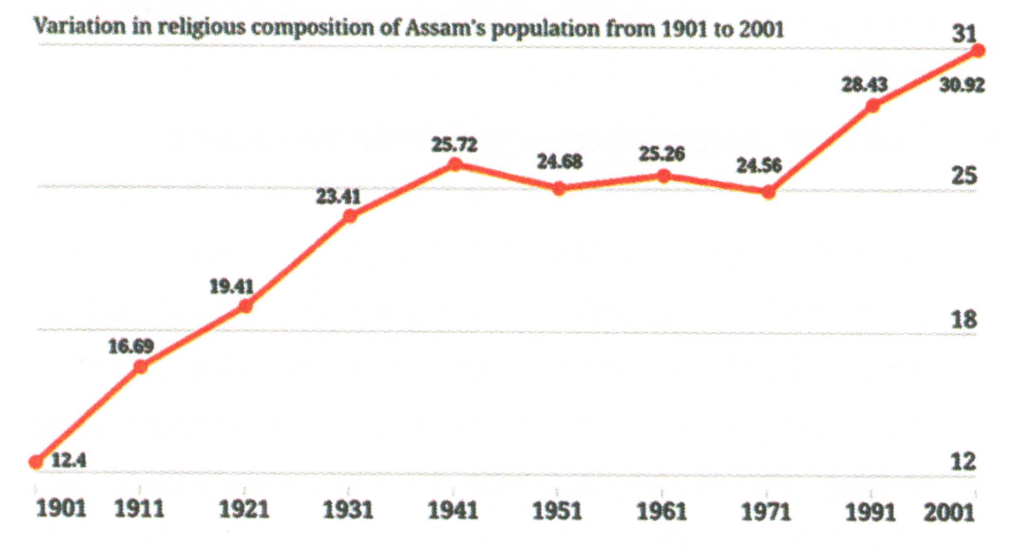
Social
- Disintegrated Society: From the 1990s to the start of 2011, over 800,000 people were forced to flee their homes in episodes of inter-ethnic violence in western Assam, along the border between Assam and Meghalaya, and in Tripura. According to an estimate, some 76,000 people remain in internal displacement in North East India due to the prolonged armed violence.
- Alienation: Due to historical reasons for segregation and cut-off from the mainland, people of North East feel alienated from rest of the country. There are also instances of violence against people of North East in other parts of country, even in capital.
- Deprivation: Most conflicts in the Northeastern region have socio-economic reasons behind them. Access to basic amenities, namely, drinking water, toilet facility and electricity reveals the existence of wide state-level variations. Inequality in access to electricity is highest in urban sector as compared to the rural sector among the three basic services.
- Internal: Long-term inward migration from other parts of India coupled with the displacement of indigenous populations and the emergence of a rapacious middle class has also exacerbated internal tensions and age-old tribal disputes in north-east region.
National Register of Citizen (NRC)
- NRC process is to address the issue of illegal migrants, specifically from Bangladesh. The NRC was first published in 1951 to record citizens, their houses and holdings. Updating the NRC to root out foreigners was a demand during the Assam Agitation (1979-1985).
- The Citizenship Act of 1955 was amended after the Assam Accord for all Indian-origin people who came from Bangladesh before January 1, 1966 to be deemed as citizens. Those who came between January 1, 1966 and March 25, 1971 were eligible for citizenship after registering and living in the State for 10 years while those entering after March 25, 1971, were to be deported.
- The final draft of the updated National Register of Citizens (NRC) in Assam listed 2.89 crore citizens. These were out of 3.29 crore applicants for inclusion.
Economical
- Unemployment: Despite having enormous natural resources like coal, hydropower potential etc., NE states remain poor. Tripura reported India’s highest unemployment rate, 25.2% in urban areas, followed closely by Nagaland with 23.8% in 2011-12.
- Low economic development: Low level of economic development has led to low percapita income and unemployment in the region. Level of tourism and other economic activities in the North Eastern States are still unrealised. Due to low level of development the youths are attracted towards the insurgent groups. The natural potential of the region is enormous which must be realised to bring development in the region.
Political
- Political backing to insurgency:
- The vote bank politics results in support coming from political leader to various insurgent groups for their narrow political gains resulting in adversely affecting social harmony and cohesiveness.
- Political setup tends to favour one militant group over others by giving economic and political concessions. Despite formation of Bodoland Territorial council (BTC) in areas dominated by Bodos, Bodo militant continues to operate in Assam through NFDB and its factions.
- Supports to the demand for Greater Nagalim by various militant groups with their definition of own has led to conflicts even among Naga groups and apprehension among other militant groups in neighbouring states.
- The Government of India in the past has dealt with each insurgent group/faction separately and has entered into agreements to suspend operations (Suspension of OperationsSoO) and allowing them participation in the political field. Several interlocutors have been appointed to carry on negotiations. For example, R N Ravi, government interlocutor for talks with Naga Insurgents.
- Lack of visionary leadership:
- State political leadership look up to union government to resolve problem of insurgency and militancy, abdicating their responsibilities. Union’s response is often late and too little leading to protracted conflicts through armed response instead of political response.
- Political settlement in Mizoram through Rajiv Lal denga agreement came after long period of conflicts in 1986. Mizoram since the agreement has been peaceful. Despite Assam Accord of 1985, successive political leadership has not been able to resolve the conflicts through political means.
- Political Instability:
- Support of ethnic groups to various political parties kept changing, leading to political instability. Political instability at state level did not allow local leadership to deal with the problems comprehensively rather they resorted to policy of appeasement of few groups at the cost of other. The bitter struggle for power between different ethnic groups and their clashes hindered democratic process.
Governance
- Issues of infrastructure, poor service delivery and lack of connectivity has been a major problems in governance. The issues of fake encounters and AFSPA has been protested by different sections of the region.
- Lack of Basic Amenities: Lack of better connectivity has been a hurdle in provisioning of basic infrastructure. Health, Education and Sanitation has been a major issue in the North East India. Also insurgent groups create blockade to stop trade and supply of essential commodities like Naga blockade in Manipur.
- Corruption: Corruption has led to flourishing of smuggling of drugs and weapons. Corruption has also harmed the governance in the region creating discontent in the population.
Reasons for Survival of Insurgency
Political Motivations
- Political motivations have been one of the strongest reason for survival of insurgency in the region. There are dozens of ethnic groups and tribes. Existing institutions in form of autonomous district councils and state government remain inadequate to accommodate all these groups. It is also not possible to create autonomous councils for all groups. Hence political motivations result in form of demand for separate district councils, state or even a separate country.
- Bodo groups are not satisfied with existing Bodoland Territorial Council (BTC). Migrants groups are often targeted as they can influence the elections results within BTC.
- Kuki insurgents want a state within a state under the Constitution as they feel neglected in the ongoing negotiation for greater nagalim in Nagaland.
Availability of Arms
- Insurgency in the Northeast has been sustained to a significant extent due to easy availability of sophisticated arms from Southeast Asia.
- The easy availability of arms in Northeast India enables the NSCN-K, the ULFA and the PLA to sustain their armed movements. Of the United Nation’s estimated 640 million illegal arms in the world, 40 million small arms are in India alone, with Manipur accounting 32 percent of small arms.
- Chinese arms manufacturing companies regularly sell small arms to insurgents in Northeast India.
- From the charge-sheet filed by the National Investigation Agency (NIA) on 26 March 2011 against National Socialist Council of Nagaland (NSCN-IM), highlighted that the insurgent group was actively buying weapons from Chinese companies.
Popular Support Base
- Popular support base is one of the important factors which help escalating the violence level of an insurgency. The insurgent groups use violence as a tool to get support from their target population. For example, ULFA is known for its violence tactics of killing non-Assamese Hindi-speaking people.
Geography and Terrain
- The narrow Siliguri corridor that connects north east India to rest part of India. This geographical reason renders NE states segregated from Mainland India. It also puts landlocked region of NE at economic disadvantage, as cross border trade is also not flourishing much.
- Extremely difficult and rugged terrain has contributed in two ways for flourishing insurgency: First, it hinders development of infrastructure which obstructs job creation. Second, it makes monitoring of illegal activities and violent tendencies in far flung areas difficult.
External Support
- The region is close to Golden Triangle of illicit drug production and act as transit to West and South Asia. Drug traffickers have developed alliance with insurgent groups. Major breakthroughs in counter-insurgency operations were only made when neighbouring countries cooperated with the Indian government. For instance, Assamese insurgents who sought refuge in Bhutan during the 1990s, could be curbed only after much diplomatic pressure was exerted on Bhutanese government to take aggressive measures, flushing out the camps in 2003’s Operation All Clear. Similarly, a peaceful end to the conflict with ULFA was negotiated only in 2011, the Bangladesh government shutdown ULFA operations across the border.
State’s Response to Armed Ethnic Insurgency
Proportionate use of Force
- Countering insurgency through deployment of armed forces, permanent stationing of paramilitary, liaisoning with neighbouring countries.
Use of Dialogues and Negotiations
- The dialogue and negotiations have always been a serious alternative option for the government’s response to the armed conflicts in the Northeast.
- Use of dialogue has seen successful resolution of conflict in Mizo Accord and in Tripura model.
- In the Naga conflict, the dialogue started as early as 1947 with the Akbar Hydari agreement, the civil society interactions of the 1950s, the Naga Peace Mission of 1964, the Shillong Accord of 1975 and the now ongoing peace negotiations with the NSCN (IM) and the NSCN (K). In the ULFA case, the jailed ULFA leaders have been released followed by “unconditional talks” with the outfit falling within the framework of negotiations.
Structural Changes
- The government of India has given considerable attention to reduce the conflicts by conferring greater statehoods in the north east. Soon after Independence, JL Nehru enunciated what came to be called the Tribal Panchsheel’. It broadly constituted the policy framework around which the development of the tribal areas was to be accomplished.
- Autonomous Administrative Areas and Sixth Schedule: These provisions have satiated the demand for autonomy to some extent. It also helped in preserving and maintaining their distinct cultures and customs, thereby resolving grievances.
- Ministry for Development of North Eastern Region (MDoNER): It was set up as Department of Development of North Eastern Region in September, 2001 and upgraded to a Ministry in May, 2004 underscoring commitment to ensure development with equity for the NER. Important activities of this ministry include:
- North Eastern Council (NEC): It was established via the North Eastern Council Act, 1971 to act as advisory body for securing balanced socio-economic development of the North Eastern region. The NEC started functioning in the year 1972. The act was amended in 2002 to make Sikkim its part.
- Look East Policy: Another structural change that has been envisioned through the ‘Look East’ policy is economic development and trade routes to South East Asia via land and sea to bring about prosperity to the Northeastern states. This policy is pertinent to insurgency in North East because it would be persuading people to reject violent means projected by the armed groups and embrace peace and development into their lives.
- Act East Policy: The Objective of “Act East Policy” is to promote economic cooperation, cultural ties and develop strategic relationship with countries in the Asia-Pacific region through continuous engagement at bilateral, regional and multilateral levels thereby providing enhanced connectivity to the States of North Eastern Region. The North East of India has been a priority in our AEP. AEP provides an interface between North East India including the state of Arunachal Pradesh and the ASEAN region. Various plans at bilateral and regional levels include steady efforts to develop and strengthen connectivity of Northeast with the ASEAN region through trade, culture, peopleto-people contacts and physical infrastructure (road, airport, telecommunication, power, etc.). Some of the major projects include Kaladan Multi-modal Transit Transport Project, the IndiaMyanmar-Thailand Trilateral Highway Project, Rhi-Tiddim Road Project, Border Haats, etc.
- Free Movement Regime: The formation of Myanmar as a separate State in 1935 and decolonisation of the sub-continent in 1947 dividedethnic communities living along theIndoMyanmar border. These communities found the newly created boundary to be inconsistent with the traditional limits of the region they inhabited. And they felt a deep sense of insecurity because they became relegated to the status of ethnic minorities on both sides of the border. To address their concerns and enable greater interaction among them, India and Myanmar governments established the Free Movement Regime (FMR), which allowed people to travel 16 km across the border on either side without any visa requirements.
Counter Insurgency Steps
- A counter-insurgency or counterinsurgency (COIN) can be defined as “comprehensive civilian and military efforts taken to simultaneously defeat and contain insurgency and address its root causes”. India has taken various political and military measures to combat counterinsurgency in North East.
- Use of Force: In 2011, the government of India had identified 79 armed insurgent groups active in six of the seven ‘Sister States’ of North East, in which some are designated as “terrorist organisations”.
- Deployment of Paramilitary along with Armed Forces: More troops were stationed permanently after the Indo-China war in 1962 and then again in 1970s, when the insurgency was at it’s peak. Large battalions have also been established to police the borders with China, Myanmar and Bangladesh.
